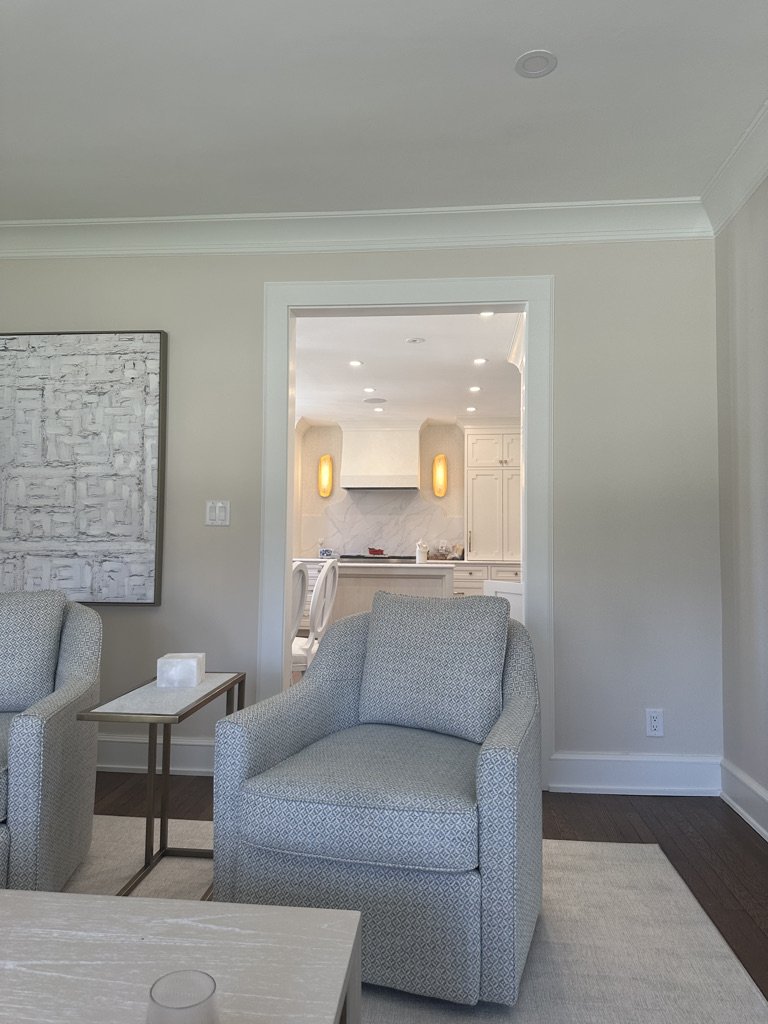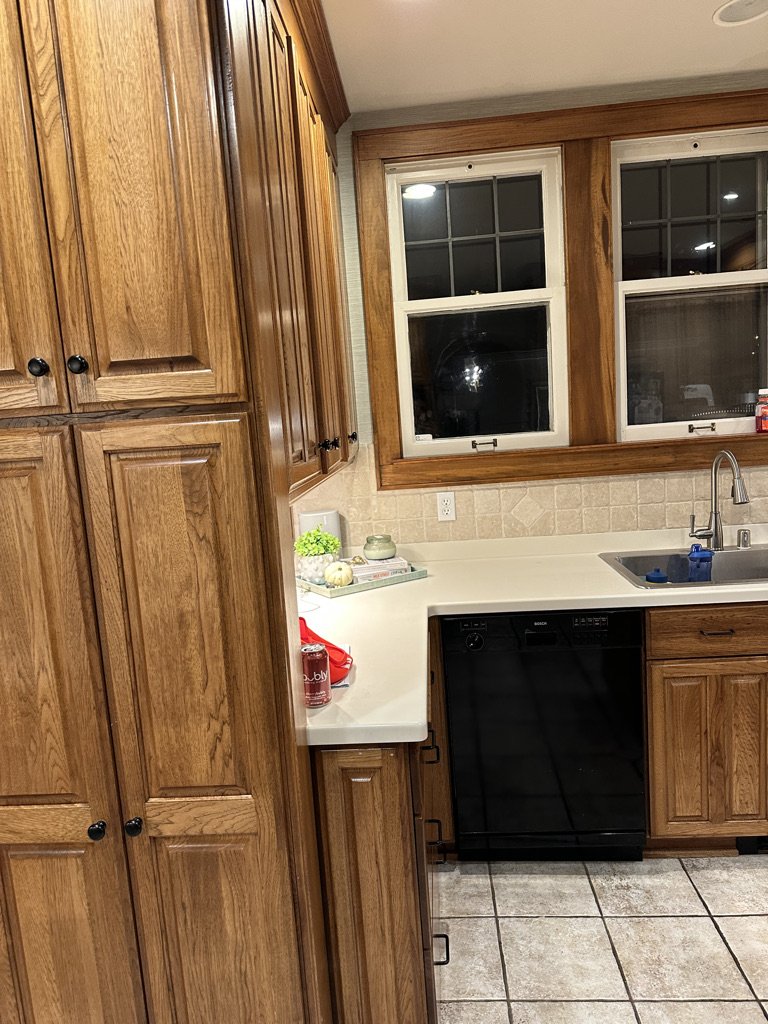Home Renovation Series Part II: Lisa's Personal Experience
Welcome to Part II of our Home Renovation Series. In Part I, we talked about the first step of a home renovation being hiring an interior designer you can trust to be on time, have excellent communication skills, and efficiently coordinate all the many moving parts of a home renovation. Most importantly, we discussed the importance of hiring an interior designer who can handle such an intense and personal project in your home.
But what is it like for an interior designer to renovate their own home? Today’s post is handled by Tiffany, my assistant who had the idea to interview me about my own process of renovating my kitchen and powder room. I loved the idea of pulling the curtains back so people can see the honest highs and lows of a renovation to help them decide if this something they’re ready to do.
As I did both my kitchen and powder room, today’s post will be focused on the kitchen. Our next post will be about the powder room and the unexpected decisions needed to be made in such a small space.
Enjoy the interview!
Tiffany: For this renovation process you tackled your kitchen. I feel like kitchen renovations are the most intimidating because it disrupts so much of your daily life. Can you tell us how long you had to function without a kitchen and how you were able to manage that with two small children?
Lisa: We were out of a kitchen for 4 months. I prepared my family letting them know we would be out of the kitchen for that long but I didn't think they realized that it would disrupt their daily lives for that long. My kids really hated that we did not have a kitchen. I think because everything had plastic over it and the only room they could hang out in was the make shift kitchen/family room. My husband didn’t like it because he couldn’t find anything. Ultimately, at the end I was burnt out and many dinners were done outside of the house the last month of renovations. But there was a light at the end of the tunnel and as each day passed we could see the completion of the kitchen. We did create a kitchen in our family room that had our toaster oven/air fryer, hot plate, and microwave. Here are some pictures of our set up and honestly it was a lot of wine drinking too that helped get us to the next phase in our life :)
Tiffany: That’s very creative! What a wonderful way to plan ahead. Speaking of planning ahead, any renovation requires many people involved at different times (and sometimes all at once). To help your readers see how important an interior designer is in the process, can you list who was involved with this process and what their role was? (sub question: How did you know who to hire and who not to hire?)
Lisa: You need a great general contractor (GC). This is the person who will make sure all of the trades (demolition crew, plumber, electrician, etc.) are there and staying on schedule. Also life happens, so if they aren’t there when you need them to be, he/she will inform you of the updated schedule. The general contractor is usually the person who will bring in all of the trades needed, but since I work in the industry I requested that some of my vendors work on the project. This was discussed at the very beginning of the project so my GC knew who was taking care of what.
As a designer, I know how critical lead times are and I make sure everyone who needs to be involved in the project understands the lead times so they can be on schedule. One way to do this is through communication. Once a week, if not more, I would meet with my GC and go through what was getting done and discuss any hiccups or delays on my end with my vendors. The GC needs to know when cabinets are being installed or when the countertop is going in so that he can adequately line up his trades to complete their work. Communication is key in making sure we were in our new kitchen within that 4-month lead time.
Tiffany: Was there anything in particular you knew ahead of time you needed to keep an eye on? Whether it was due to supply chain issues, systemic communication issues between vendors, or simply the trickiness of a project?
Lisa: Trades are very busy. Their schedule has not slowed down so you need to be mindful of their schedule. For example, my wallpaper hanger schedule is typically booked out 3-4 months, so I walked her through my project as soon as dry wall went up. Then I got on her schedule by quickly giving her a deposit. Sometimes I find clients receive the quote and take a week or two to put the deposit down. For me, I knew if I wanted particular dates, I needed to lock down her schedule dates by giving her a deposit immediately.
Our chain supply has gotten MUCH better! But, that being said, I had everything onsite before demo. That way if the electrician needed to see the light fixture or plumber needed dimensions of a sink, it was right there for us to look at. I also had to work closely with the GC to make sure my vendors were scheduled at the proper times.
Tiffany: Comparing your first renovation to this one, are there any key lessons you learned that have stuck with you through the years?
Lisa: I'm constantly learning in this industry. It’s wild after doing renovations for myself and others for over 18 years there are still things I'm learning about. All of my projects are completely different from my clients’ overall personal and design goals, budgets, and timelines, but what’s not different is they want the end result to be beautiful! I find it crucial to find a designer who understands the construction timeline and has experience and knowledge of the construction process.
Tiffany: I love that you’re constantly learning. How has the renovation industry changed since you began?
Lisa: The process is still the same. As well as certain codes or standard practices that need to be met. A thing that’s always revolving is the design style and materials. When I first started, subway tiles for bathrooms and backsplashes were hot, granite counter tops were being used frequently, and the color palette was earth tones. I also see how technology has completely involved too. Before we use to build huge entertainment centers to house TV's. Now we just need an outlet and a wall. Social media has been a huge help communicating my design ideas. I can quickly pull up a "design concept" on Pinterest to show the millworker how I want the mantel detail to be built out. These pictures that are on various social media sites are also so helpful to use as design inspiration for my projects. When you have a designer who helps you from the start to finish there’s less stress when answering questions that can play a huge role in the end result.
Tiffany: You’re known in the industry for your technical abilities and ability to problem solve. What technical knowledge was helpful for this kitchen renovation? Could someone do a kitchen renovation without having this knowledge?
Lisa: Sure... anyone can work with all of the trades in order to complete a kitchen renovation, but I wouldn’t recommend it. I've been helping clients for the past 18 years on renovation projects and new construction. I have seen a lot in the years on what to do and not do. I’ve made mistakes and learned from them. I’ve seen other designers and contractors make mistakes and I've grown and learned from those situations. A simple statement that I use a lot in my life… ”You don't know what you don't know.” During a construction project there are about one million decisions that need to be made. Once those decisions are made (selecting the material and signing off on the layout, etc.) now comes the 2 million questions that will start rolling in during the construction process.
Tiffany: Would you do anything differently for the next time?
Lisa: I'm overall ecstatic with the way my kitchen turned out. But are there things that I would adjust and fix. That’s the beauty of what I do; I’m consistently designing and helping others make their space beautiful. I'll be able to use this knowledge in the next project and can help direct my clients on things they should avoid. For example, I have grass cloth wallpaper on the walls of my kitchen but in the kitchen nook I wanted something that was cleanable. I added wainscotting around the kitchen table so I can easily clean this area. When the carpenter asked me how I wanted the profile of molding piece to cap off the wainscotting, I selected something that is a little bit too big and chunky for that space. I wish I selected a smaller profile for that piece. It’s a small detail but does make a HUGE of difference. It was a mistake on my part, but I’ll be using this knowledge in the next project. When you have an experience designer in your back pocket understanding your overall goal and design aesthetic, that designer will be making informed decisions that will overall positively affect the end goal which is having a beautiful kitchen/home.
Tiffany: Thank you for letting us into your mind and home. I can’t wait to see photos of the finished product!
Thank you, Tiffany, for asking such a great questions! I had a wonderful time recounting this experience. Even after eighteen years of renovating, I still feel such joy and excitement talking about each project I’ve done. I can’t wait to share with you the next set of questions about my powder room. To be notified of our next post, subscribe to our blog by filling in your email address at the end of this page.
















